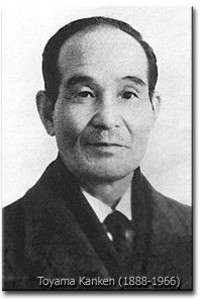Shūdōkan

Shudokan (修道館 Shūdōkan), literally "the hall for the study of the way of karate," is a Japanese school of karate developed by Kanken Toyama (1888 – 1966). It was the total headquarters of Japan Karate Federation (old). Characteristics of Shudokan karate include large circular motions with an emphasis on covering and its own unique kata.[1]
History
Toyama's karate training began at the age of nine in 1897 with Itarashiki, although he studied with Yatsusune Itosu for 18 years, until the latter's death in 1915. In 1907 Toyama was appointed "shihandai" (assistant master) to Itosu at the Okinawa Teacher's College, and he and Gichin Funakoshi, who later developed Shotokan karate, were the only two students to be granted the title of shihanshi (protégé). Some people believe that Kanken Toyama outranked Gichin Funakoshi, who did not have the rank of shihandai.
In 1924 Toyama moved his family to Taiwan, where he taught in an elementary school and studied Chinese Ch'uan Fa, which included Taku, Makaitan, Rutaobai, and Ubo. In early 1930 he returned to Japan and on March 20, 1930, he opened his first dojo in Tokyo. He named his dojo Shu Do Kan meaning "the hall for the study of the karate way." Toyama taught what he had learnt from Itosu and the Ch'uan Fa and did not claim to have originated a new style of karate. In 1946, Toyama founded the All Japan Karate-Do Federation (AJKF) with the intention of unifying the various forms of karate of Japan and Okinawa under one governing organization.
When GHQ announced the martial arts ban in 1945, disciples of Shūdōkan a dojo studio called Kanbukan (韓武舘) for the purpose of escaping from a martial arts ban. Kanbukan was the meaning called the martial arts of Korea, and disciples kept Karate of Kanken Toyama by camouflage from GHQ. Kanbukan changes renbukan and the name later and forms JKF. Shudokan becomes the headquarters of Japan Karate Federation (old) then. JKF(old) is current JKF Renbukai.
As Toyama did not view the Shu Do Kan as a distinct style of karate, but merely a place for training, he did not appoint a successor. Thus, the organization he founded fragmented after his death in 1966, although his student Toshi Hanaue maintained the original Shu Do Kan. A few other schools based on Toyama's teachings still exist such as Doshinkan. Today, a minimal overseeing of the Toyama lineage of Karate is done by Kanken Toyama's son, Ha Toyama.
Shudokan Today
Shudokan karate today is essentially a compound system, including Kobudo (i.e. "ancient art," referring to the specialized weapons practice of traditional Okinawan karate) and Shorin-Ryu (also known as Itosu-ha). Many other principles from other styles have found their way into Shudokan as it was Toyama's wish that Shudokan not stagnate, that it should grow in efficiency and flourish.
Japan
In addition, the Karate that Toyama taught in Shudokan is spread now in JKF Renbukai.
U.S.A.
Many current practitioners of Shudokan Karate would concur that Toyama's wish for Shudokan is still being upheld. In the United States the art of Shudokan Karate is being taught, however different in some ways, by the American Shudokan Association (ASA) under the leadership of Morris Mack of Yakima, Washington. The ASA, with over 15,000 members in the Pacific Northwest region of the United States, was founded by Walter Todd and Morris Mack in the 1980s. Walter Todd was a student under Yoko Takahashi who was a direct student of Kanken Toyama. Later, Kanken Toyama appointed Walter Todd as Shibu-cho (Branch Director) for the U.S., authorizing him to rank students in Shudokan (Toyama-Style) karate and direct the development of Shudokan in America. After Toyama's passing, his son, Ha Toyama, approved Todd's rank of eighth rank.a
Walter Todd died at the age of 72 on November 26, 1999.
Influence on Tang Soo Do and Taekwondo via Korean students
Of the nine schools, or Kwan's (Kan) that merged to form Taekwondo, four of those schools have lineages that trace back to Toyama Sensei through three Korean men who trained in Japan while Korea was under Japanese occupation. These three men were Kim Ki Whang, Yon Kwai Byeong and Yoon Byung In. Yon and Yoon both trained with Toyama Sensei and are both listed in his student role books as "Shihan." Both these men taught a mixture of Toyama Sensei's methods along with the Chuan Fa they learned in Manchuria, before the Taekwondo unification movement. At that time, they founded Tang Soo Do or Kong Soo Do schools in Korea. The first Kwan (Kan) where they worked as teachers was the Jidokwan. Kim Ki Whang received his 3rd dan from Toyama Sensei and had moved to the U.S.A in the early 1960s to teach Taekwondo. Later, the Chang Moo Kwan, Han Moo Kwan and Kang Duk Won branched off from the first Kwan. This is according to Han Moo Kwan founder Kyo Yoon Lee as written in his book Global Taekwondo 2009, and, A Modern History of Taekwondo, by Won Sik Kang and Kyong Myung Lee (1999).
References
- JKF Renbukai(In Japanese)
- Renbukai kanagawa branche (In English)
- World Renbukai blog
- Shudokan Martial Arts Association
- International Shudokan Karate Association
- History of Shudokan Karate
- American Shudokan Association Hombu dojo for the US
- Shudokan Internacional School Karate Do
- Karatedo International Doshinkan
- Shudokan Mexico
- Shudokan Argentina